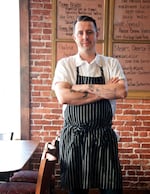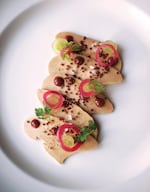Chef Gabriel Rucker, the award-winning chef and main creative force behind Portland's Le Pigeon restaurant — which serves such items as foie gras johnny cake and beef cheek bourguignon — has collaborated with his colleagues to publish his first cookbook. Rucker is also chef and co-owner of Little Bird Bistro.
Whether fans of the restaurant will be able to re-create the dishes — things like pigeon crudo and rabbit and eel terrine — is another question.
The book, Le Pigeon: Cooking at the Dirty Bird, is brimming with pictures, some mouthwatering and others which may be more difficult to view, depending on your perspective. On one page is a delicious looking, maple-lacquered squab. On another is a graphic picture of a severed, raw cow tongue. The book also includes 125 recipes, as well as photographs and stories about the people behind the food. View the recipe for Foie Gras Carpaccio.
Chef Gabriel Rucker talked about the book and the restaurant with Think Out Loud's Allison Frost.
Note: This interview was edited for clarity and brevity. Hear the full Think Out Loud interview.
Allison Frost: Way back when you landed your very first chef job in California, what did you like about it?
Gabriel Rucker: It kind of was something that came naturally to me. I could look at a car engine and never put a carburetor back in it, but food started to fall into place. And there was actually a sense of community in the kitchen. I was kind of the young, gangly kid, but I was interested in it and I put 110 percent into it, and so people kind of took me under their wing — taught me how to make sauces, how to make risotto, how to season the right way, and I just kind of fell in love with it.

Chef Gabriel Rucker has written a cookbook featuring recipes from his Portland restaurant Le Pigeon.
David Reamer / Ten Speed Press
AF: How did Le Pigeon start? That obviously wasn’t your first job in Portland.
GR: Le Pigeon was kind of an accident almost. A friend introduced me to our now silent business partner Paul Brady, who was the owner of a restaurant where Le Pigeon is. It actually looked pretty similar to how Le Pigeon looks now. It wasn't going too well for him, and he was not in the restaurant business before and so [he was] kind of naïve to hire a 25-year-old kid who said he could do it without ever actually tasting his food. But he went out on a limb, and I just got in the kitchen and started making food. We had days when no one would show up to eat dinner. I used to get out of work at about 9 o'clock back in those days.
AF: Tell me briefly how you came up with the name. I understand it was from a tattoo.
GR: I had a tattoo on my arm that said 'Le Pigeon.' It was the second tattoo that I got. It says 'Le Pigeon' with a flock of pigeons. I love cooking and eating small little birds. That's something I learned at my first job. This old Brooklyn dude named Benny [would] just snack on quails and [say] 'I just love eating little birds with bones,' and I was a sponge at that point so I picked up on that. And I like eating and cooking pigeon. And also in French slang the pigeon is kind of the guy that does the dirty work.
AF: That’s how you see yourself?
GR: Let's put it this way: I was definitely down on my hands and knees with a rag of bleach yesterday.
AF: Well, let's get to the food a little bit. You’ve said that tongue and foie gras are two of your favorite ingredients. How did that happen?
GR: I don't know. It wasn't really a conscious thing. As far as the tongue and those off cuts, when we opened up The Pigeon, we were doing it on a shoestring budget, and those were kind of the items that I could buy or order from a meat company and make interesting. So it was a standout rather than when I was cooking down in Santa Cruz, every restaurant had a filet mignon with some mashed potatoes and maybe green beans or asparagus. But a tongue or a pig's foot or the brain, you can get it cheap, cook it for a long time, put it on your menu and people would remember that ...
[Foie gras] is just such a versatile ingredient. We do so many things with it. We serve it as a carpaccio in the cookbook [and] as a torchon, which is like a log. Seared, we make a bacon out of it. It's just so versatile. We make ice cream for our signature dessert out of it. So I think the versatility of the ingredient makes it fun, because when you have one ingredient that you can make wear so many different hats, then it's never boring.
AF: How does your layering of flavors work? Can you give us an example of a recipe in particular in your new book where that’s key?
To learn more about the food at Le Pigeon and the new cookbook, as well as Rucker's trip to France, listen to the full interview on OPB's Think Out Loud.
Recipe: Foie Gras Carpaccio

Foie Gras Carpaccio, from Le Pigeon: Cooking at the Dirty Bird
David Reamer / Ten Speed Press
- 1/2 teaspoon green cardamom seeds
- 2 tablespoons kosher salt
- 1/4 teaspoon pink curing salt
- 2 1/2 teaspoons sugar
- 1/2 teaspoon ground cardamom, plus more for serving
- 1 lobe foie gras, about 1 pound (480 g), cleaned and deveined
- 4 pearl onions
- 1/4 cup (60 ml) champagne vinegar
- 2 tablespoons water
- 1 tablespooon sugar
- 1 teaspoon kosher salt
- 1/2 cup (100 g) seedless green grapes, peeled and sliced
- 1/4 cup (50 g) puffed quinoa
- 1 1/2 cups (325 ml) Saba grape syrup
- Fresh chervil sprigs for garnish
- To make the cure, in a small, dry saucepan over medium heat, toast the cardamom seeds, shaking the pan constantly, until aromatic, about 2 minutes. Remove the pan from the heat and let the seeds cool. Pour the seeds into a spice grinder and grind into a powder.
- In a small bowl, mix together the ground cardamom seeds, the kosher salt, curing salt, sugar and ground cardamom. Rub the cure all over the foie gras, letting any excess fall off. Place the coated foie in a resealable plastic bag, pressing as much air out of the bag as possible. Cure in the refrigerator for 24 hours.
- The next day, place a serving platter in the refrigerator to chill. To make the pickled onions, peel the pearl onions and slice them into thin rings. Place the rings in a small bowl and set aside. In a small saucepan over medium heat, combine the vinegar, water, sugar and salt and bring to a simmer. Pour the vinegar mixture over the onions and let them cool to room temperature. (They can be stored in an airtight container in the refrigerator for up to a month.)
- Remove the foie lobe from the fridge and, under running cool water, carefully rinse off the cure. Gently pat dry. (At this point, the foie can be stored in the refrigerator in an airtight container for up to 4 days.)
- To serve, warm a very sharp knife under running water and dry it with a towel. Gently slice the foie gras into very thin slices and layer them across the cold platter. Sprinkle the foie carpaccio with a pinch each of Maldon salt and ground cardamom. Scatter the grapes and pickled onions on top of the foie and sprinkle with puffed quinoa. Drizzle the grape syrup over the top and garnish with chervil.
Reprinted with permission from Le Pigeon by Gabriel Rucker & Meredith Erickson, copyright © 2013. Published by Ten Speed Press, a division of Random House, Inc.